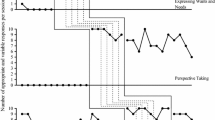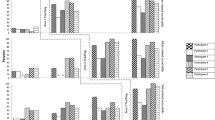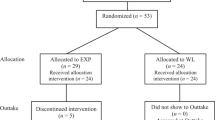Abstract
Social skill training for individuals with autism spectrum disorder (ASD) frequently targets skill accuracy. However, restricted and repetitive social behaviors are infrequently addressed. The present study evaluated the efficacy of a modified version of the Program for the Education and Enrichment of Relational Skills (PEERS) intervention for improving social skill accuracy as well as increasing novel responding in three children with ASD. The intervention was facilitated by graduate student researchers in a clinic-based setting, and targeted social skills included Two-way Conversation, Finding Similar Interests, and Starting a Conversation. A multiple baseline design across skills was utilized to evaluate the effects of the modified PEERS. Results demonstrated that the intervention was generally effective in improving skill accuracy across participants, as well as increasing novel responding in response to prompts delivered by both researchers and parents. The current study provides a model for modification of extant social skill training curricula to incorporate strategies that may address restricted and repetitive social behaviors in individuals with ASD.






Similar content being viewed by others
References
Adami, S., Falcomata, T. S., Muething, C. S., & Hoffman, K. (2017). An evaluation of lag schedules of reinforcement during functional communication training: effects on varied mand responding and challenging behavior. Behavior Analysis in Practice, 10, 209–213.
Argott, P. (2010). Increasing the variability of verbal responding in children and adolescents with autism using a conjunctive-differential reinforcement schedule. New York: City University of New York.
Barry, T. D., Klinger, L. G., Lee, J. M., Palardy, N., Gilmore, T., & Bodin, S. D. (2003). Examining the effectiveness of an outpatient clinic-based social skills group for high-functioning children with autism. Journal of Autism and Developmental Disorders, 33, 685–701.
Bellini, S., & Hopf, A. (2007). The development of the Autism Social Skills Profile: a preliminary analysis of psychometric properties. Focus on Autism and Other Developmental Disabilities, 22, 80–87.
Bellini, S., Peters, J. K., Benner, L., & Hopf, A. (2007). A meta-analysis of school-based social skills interventions for children with autism spectrum disorder. Remedial and Special Education, 28, 153–162.
Carter, A. S., Davis, N. O., Klin, A., & Volkmar, F. R. (2005). Social development in autism. In F. R. Volkmar, R. Paul, A. Klin, & D. Cohen (Eds.), Handbook of autism and pervasive developmental disorders (Vol. 1, Third ed., pp. 312–334). Hoboken, NJ: John Wiley & Sons.
Cederlund, M., Hagberg, B., Billstedt, E., Gillberg, I. C., & Gillberg, C. (2008). Asperger syndrome and autism: a comparative longitudinal follow-up study more than 5 years after original diagnosis. Journal of Autism and Developmental Disorders, 38, 72–85.
Fisher, W. W., Rodriguez, N. M., & Owen, T. M. (2013). Functional assessment and treatment of perseverative speech about restricted topics in an adolescent with Asperger syndrome. Journal of Applied Behavior Analysis, 46, 307–311.
Ganz, J. B., Kaylor, M., Bourgeois, B., & Hadden, K. (2008). The impact of social scripts and visual cues on verbal communication in three children with autism spectrum disorders. Focus on Autism and Other Developmental Disabilities, 23, 79–94.
Gast, D. L. (2010). Single-subject research in behavioral sciences. New York, NY: Routledge.
Goldstein, S., & Naglieri, J. A. (2009). Autism spectrum rating scales. Tonawanda, NY: MultiHealth Systems.
Gresham, F. M., & Elliott, S. N. (1987). The relationship between adaptive behavior and social skills. The Journal of Special Education, 21, 167–181.
Howlin, P., Mawhood, L., & Rutter, M. (2000). Autism and developmental receptive language disorder—a follow-up comparison in early adult lift. II: Social, behavioural, and psychiatric outcomes. Journal of Child Psychology and Psychiatry, 41, 561–578.
Howlin, P., & Moss, P. (2012). Adults with autism spectrum disorders. The Canadian Journal of Psychiatry, 57, 275–283.
Jenson, W. R., Bowen, J., Clark, E., Block, H. M., Gabrielsen, T., Hood, J. A., et al. (2011). Superheroes social skills. Eugene, OR: Pacific Northwest.
Karst, J. S., Van Hecke, A. V., Carson, A. M., Stevens, S., Schohl, K., & Dolan, B. (2015). Parent and family outcomes of PEERS: a social skills intervention for adolescents with autism spectrum disorder. Journal of Autism and Developmental Disorders, 45, 752–765.
Kratochwill, T., Hitchcock, J., Horner, R., Levin, J., Odom, S., Rindskopf, D., & Shadish, W. (2010). Single-case designs technical demonstration. Retrieved from http://ies.ed.gov/ncee/wcc/pdf/reference_resources/wwc_scd.pdf
Laugeson, E. A., & Frankel, F. (2011). Social skills for teenagers with developmental and autism spectrum disorders: the PEERS treatment manual. New York: Routledge.
Laugeson, E. A., Frankel, F., Mogil, C., & Dillon, A. R. (2009). Parent-assisted social skills training to improve friendships in teens with autism spectrum disorders. Journal of Autism and Developmental Disorders, 39, 596–606.
Laugeson, E. A., Frankel, F., Gantman, A., Dillon, A. R., & Mogil, C. (2012). Evidence-based social skills training for adolescents with autism spectrum disorders: the UCLA PEERS program. Journal of Autism and Developmental Disorders, 42, 1025–1036.
Laugeson, E. A. (2014). The PEERS curriculum for school-based professionals: social skills training for adolescents with autism spectrum disorder. New York: Routledge.
Laugeson, E. A., Ellingsen, R., Sanderson, J., Tucci, L., & Bates, S. (2014). The ABC's of teaching social skills to adolescents with autism spectrum disorder in the classroom: The UCLA PEERS program. Journal of Autism and Developmental Disorders, 44, 2244–2256.
Laugeson, E. A., Gantman, A., Kapp, S. K., Orenski, K., & Ellingsen, R. (2015). A randomized controlled trial to improve social skills in young adults with autism spectrum disorder: the UCLA PEERS® program. Journal of Autism and Developmental Disorders, 45, 3978–3989.
Lawrence, D. H., Alleckson, D. A., & Bjorklund, P. (2010). Beyond the roadblocks: transitioning to adulthood with Asperger’s disorder. Archives of Psychiatric Nursing, 24, 227–238.
Lee, R., McComas, J. J., & Jawor, J. (2002). The effects of differential and lag reinforcement schedules on varied verbal responding by individuals with autism. Journal of Applied Behavior Analysis, 35, 391–402.
Lee, R., & Sturmey, P. (2014). The effects of script-fading and a Lag-1 schedule on varied social responding in children with autism. Research in Autism Spectrum Disorders, 8, 440–448.
Lepper, T. L., Devine, B., & Petursdottir, A. I. (2017). Application of a lag contingency to reduce perseveration on circumscribed interests. Developmental Neurorehabilitation, 20, 313–316.
Mandelberg, J., Laugeson, E. A., Cunningham, T. D., Ellingsen, R., Bates, S., & Frankel, F. (2014). Long-term treatment outcomes for parent-assisted social skills training for adolescents with autism spectrum disorders: the UCLA PEERS program. Journal of Mental Health Research in Intellectual Disabilities, 7, 45–73.
Murzynski, N. T., & Bourret, J. C. (2007). Combining video modeling and least-to-most prompting for establishing response chains. Behavioral Interventions, 22, 147–152.
Page, S., & Neuringer, A. (1985). Variability is an operant. Journal of Experimental Psychology: Animal Behavior Processes, 11, 429–452.
Paul, R., Orlovski, S. M., Marcinko, H. C., & Volkmar, F. (2016). Conversational behaviors in youth with high-functioning ASD and Asperger syndrome. Journal of Autism and Developmental Disorders, 39, 115–125.
Radley, K. C., Dart, E. H., Moore, J. W., Battaglia, A. A., & LaBrot, Z. C. (2017a). Promoting accurate variability of social skills in children with autism spectrum disorder. Behavior Modification, 41, 84–112.
Radley, K. C., Dart, E. H., Moore, J. W., Lum, J. D. K., & Pasqua, J. (2017b). Enhancing appropriate and variable responding in young children with autism spectrum disorder. Developmental Neurorehabilitation, 20, 538–548.
Reichow, B., & Volkmar, F. R. (2010). Social skills interventions for individuals with autism: evaluation for evidence-based practices within a best evidence synthesis framework. Journal of Autism and Developmental Disorders, 40, 149–166.
Schohl, K. A., Van Hecke, A. V., Carson, A. M., Dolan, B., Karst, J., & Stevens, S. (2014). A replication and extension of the PEERS intervention: examining effects on social skills and social anxiety in adolescents with autism spectrum disorders. Journal of Autism and Developmental Disorders, 44, 532–545.
Simek, A. N., & Wahlberg, A. C. (2011). Test review: autism spectrum rating scales. Journal of Psychoeducational Assessment, 29, 191–195.
Stokes, T. F., & Baer, D. M. (1977). An implicit technology of generalization. Journal of Applied Behavior Analysis, 10, 349–367.
Susa, C., & Schlinger, H. D. (2012). Using a lag schedule to increase variability of verbal responding in an individual with autism. The Analysis of Verbal Behavior, 28, 125–130.
Tager-Flusberg, H., Paul, R., & Lord, C. (2005). Communication in autism. In F. Volkmar, A. Klin, R. Paul, & D. Cohen (Eds.), Handbook of autism and pervasive developmental disorders (pp. 335–364). New York: Wiley.
Weiss, M. J., & Harris, S. L. (2001). Teaching social skills to people with autism. Behavior Modification, 25, 785–802.
White, S. W., Keonig, K., & Scahill, L. (2007). Social skills development in children with autism spectrum disorders: a review of the intervention research. Journal of Autism and Developmental Disorders, 37, 1858–1868.
Winter, J. C. F. (2013). Using the Student’s t-test with extremely small samples. Practical Assessment, Research, and Evaluation, 18, 1–12.
Wolfe, K., Slocum, T. A., & Kunnavatana, S. S. (2014). Promoting behavioral variability in individuals with autism spectrum disorders: a literature review. Focus on Autism and Other Developmental Disabilities, 29, 180–190.
Yoo, H. J., Bahn, G., Cho, I. H., Kim, E. K., Kim, J. H., Min, J. W., et al. (2014). A randomized controlled trial of the Korean version of the PEERS® parent-assisted social skills training program for teens with ASD. Autism Research, 7, 145–161.
Author information
Authors and Affiliations
Contributions
KCR designed the study, supervised execution of the study, conducted data analysis, and wrote the manuscript. KAH assisted with the design of the study, facilitated intervention sessions, collected data, and collaborated in writing of the manuscript. ANM facilitated the intervention sessions, collected data, and collaborated in writing of the manuscript. MGM collected data and collaborated in writing of the manuscript. ELL collected data and collaborated in writing of the manuscript.
Corresponding author
Ethics declarations
Conflicts of Interest
All authors of the study report that they have no conflicts of interest.
Ethical Approval
All procedures performed in the current study were in accordance with the ethical standards of the institution and the national research committee and with the 1964 Helsinki Declaration and its later amendments. Prior to conducting the current study, Institutional Review Board approval was obtained from the University of Southern Mississippi.
Informed Consent
Informed consent and assent were obtained for all individual participants included in the study.
Rights and permissions
About this article
Cite this article
Radley, K.C., Helbig, K.A., Murphy, A.N. et al. The Effects of a Modified PEERS Curriculum on Accurate and Novel Responding of Children with Autism Spectrum Disorder. Adv Neurodev Disord 2, 412–424 (2018). https://doi.org/10.1007/s41252-018-0077-1
Published:
Issue Date:
DOI: https://doi.org/10.1007/s41252-018-0077-1




